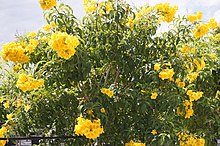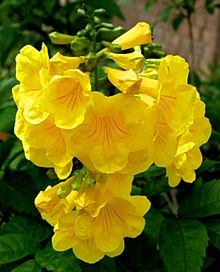bio.wikisort.org - Plant
Tecoma stans is a species of flowering perennial shrub in the trumpet vine family, Bignoniaceae, that is native to the Americas. Common names include yellow trumpetbush,[3] yellow bells,[3] yellow elder,[3] ginger-thomas. Tecoma stans is the official flower of the United States Virgin Islands and the floral emblem of The Bahamas.
| Tecoma stans | |
|---|---|
 | |
Conservation status | |
| Scientific classification | |
| Kingdom: | Plantae |
| Clade: | Tracheophytes |
| Clade: | Angiosperms |
| Clade: | Eudicots |
| Clade: | Asterids |
| Order: | Lamiales |
| Family: | Bignoniaceae |
| Genus: | Tecoma |
| Species: | T. stans |
| Binomial name | |
| Tecoma stans (L.) Juss. ex Kunth | |
| Synonyms[2] | |
| |
Description
A semi-evergreen shrub that can grow to a small tree, it features sharply toothed, opposite green leaves that are pinnate unpaired, with 3 to 13 serrate, 8 to 10 cm long leaflets. The leaflets, glabrous on both sides, have an elliptical lanceolate blade 2–10 cm long and 1–4 cm wide, with a long acuminate apex and a wedge-shaped base. The margin is finely toothed It reaches heights of 6 to 9 meters.
The large, showy, golden yellow, trumpet-shaped flowers are in clusters at the branch ends, are bell-shaped-funnel-shaped, five-lobed (with weakly two-lipped), often reddish-veined in the throat and 3.5 to 8.5 cm long. Flowering takes place all year round. The fruits arise from two carpels and are up to 25 cm long, narrow capsules. The flowers attract bees, butterflies, and hummingbirds.[4] The plant produces pods containing yellow seeds with papery wings. They release many seeds with membranous wings when they open. Tecoma stans reproduces sexually (by anemochory) or asexually.
Habitat
Tecoma stans is native to the Americas. It extends from the southern United States through Mexico, Central America, and the Antilles to northern Venezuela, and through the Andes mountain range to northern Argentina. It was introduced in southern Africa, India, and Hawaii.
Yellow trumpetbush is a ruderal species, readily colonizing disturbed, rocky, sandy, and cleared land and occasionally becoming an invasive weed. It thrives in a wide variety of ecosystems, from high altitude temperate forests and tropical deciduous and evergreen forests, to xerophilous scrub and the intertropical littoral. It quickly colonizes disturbed, rocky, sandy, and cleared fields. The species prefers dry and sunny regions of the coast.
Cultivation

Esperanza is drought-tolerant and grows well in warm climates. It is an attractive plant that is cultivated as an ornamental. They are grown in many parts of the world for their beautiful flowering, to adorn streets and gardens. It can be easily propagated by stem cuttings.
Uses
The wood is used in rustic architecture like bahareque, for the construction of furniture and canoes, or as firewood or charcoal. It is a medicinal plant used against diabetes and against diseases of the digestive system, among other uses. The plant is desirable fodder when it grows in fields grazed by livestock. The other name of this plant is Stenolobium Stans, it is also called piliya in urdu. It is a very potent anti-venom against cobra venom, used by Pakistani old medicine. It is proved to be better than anti-sera, the paste of this plant's leaves are applied topically on the cobra bite. Its bio-chemicals bind with the cobra venom enzymes thus effectively inhibiting the venom.[5]
Invasiveness
It has invasive potential and occasionally becomes a weed. The species is considered invasive in Africa (especially South Africa), South America, Asia, Australia and the Pacific Islands. It now presents a significant danger for biodiversity. It competes with local species and can form thick, almost monospecific thickets.
Gallery
- Scrubby bush
- Pollen grain of yellow elder
- Fruit
- Branching tree
- Large shrub
- Large tree flowering
- As a garden plant
- Front yard plant
- Tree with fruit
- As a street tree
- Plant by the road
References
- Botanic Gardens Conservation International (BGCI) & IUCN SSC Global Tree Specialist Group (2019). "Tecoma stans". IUCN Red List of Threatened Species. 2019: e.T82858855A149060597. doi:10.2305/IUCN.UK.2019-3.RLTS.T82858855A149060597.en. Retrieved 30 May 2022.
- theplantlist.org
- "Tecoma stans". Germplasm Resources Information Network (GRIN). Agricultural Research Service (ARS), United States Department of Agriculture (USDA). Retrieved 22 December 2017.
- Mendonça, Luciana Baza; Anjos, Luiz dos (March 2005). "Beija-flores (Aves, Trochilidae) e seus recursos florais em uma área urbana do Sul do Brasil" [Hummingbirds (Aves, Trochilidae) and their flowers in an urban area of southern Brazil]. Revista Brasileira de Zoologia (in Portuguese). 22 (1): 51–59. doi:10.1590/S0101-81752005000100007.
- Asad, Muhammad Hassham Hassan Bin; Murtaza, Ghulam; Ubaid, Muhammad; Sajjad, Ashif; Mehmood, Rubada; Mahmood, Qaisar; Ansari, Muhammad Muzzmil; Karim, Sabiha; Mehmood, Zahid; Hussain, Izhar; Hussain, I (2014). "Naja naja karachiensis Envenomation: Biochemical Parameters for Cardiac, Liver, and Renal Damage along with Their Neutralization by Medicinal Plants". BioMed Research International. 2014: 970540. doi:10.1155/2014/970540. PMC 4022246. PMID 24877153.
External links
На других языках
- [en] Tecoma stans
[es] Tecoma stans
El tronador o tronadora (Tecoma stans) es un arbusto o árbol de la familia de las bignoniáceas, nativo del continente Americano. Se encuentra en gran variedad de Ambientes y en casi todos los continentes.[1] Se cultiva como planta ornamental por sus vistosas flores amarillas. Tiene gran variedad de usos y más de 50 componentes químicos.[ru] Текома прямостоячая
Теко́ма прямостоя́чая[2], Теко́ма прямая[3] (лат. Tecoma stans) — многолетний кустарник, типовой вид рода Текома (Tecoma) семейства Бигнониевые (Bignoniaceae).Другой контент может иметь иную лицензию. Перед использованием материалов сайта WikiSort.org внимательно изучите правила лицензирования конкретных элементов наполнения сайта.
WikiSort.org - проект по пересортировке и дополнению контента Википедии











